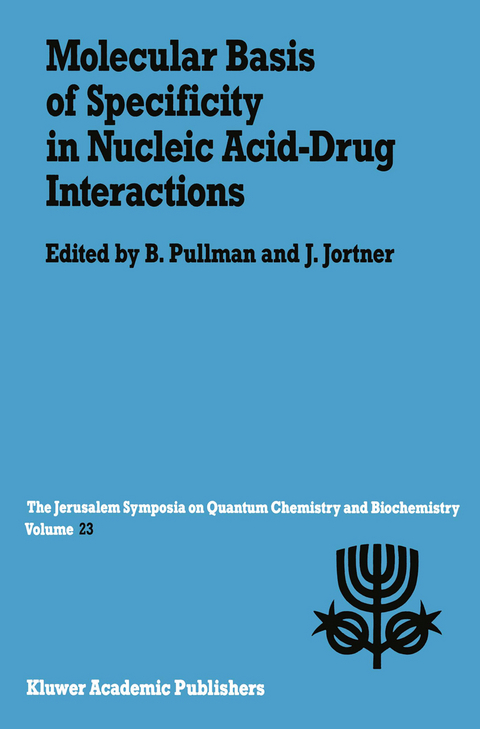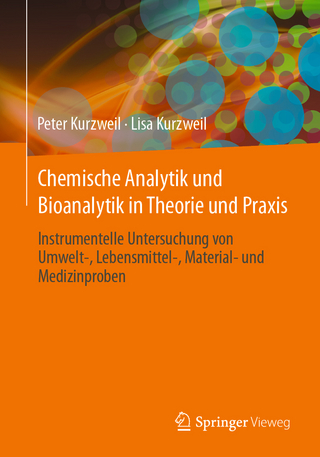
Molecular Basis of Specificity in Nucleic Acid-Drug Interactions
Springer (Verlag)
978-94-010-5657-1 (ISBN)
Mutual Conformational Adaptation of Both Ligand and Receptor in Antitumor Drug-DNA Complexes.- DNA Drug Interactions studied with Polarized Light Spectroscopy : the DAPI Case.- Drug-DNA Recognition : Sequence Specificity of the DNA Minor Groove Binder Berenil.- Binding of Minor Groove Ligands to Short DNA Segments : Berenil Complexed with d(GCAATTGC)2 and d(GCTTAAGC)2.- The Sequence Specificity of Damage Caused by [125I]-Labelled Hoechst 33258 and UV/IodoHoechst 33258 in Intact Cells and in Cloned Sequences of Purified DNA which differ by a Small Number of Base Substitutions.- Structure and Dynamics of a [1:1] Drug-DNA Complex : Analysis of 2D NMR Data Using Molecular Mechanics and Molecular Dynamics Calculations.- Determination of Distamycin-A Binding Modes by NMR.- Molecular Mechanisms of DNA Sequence Recognition by Groove Binding Ligands : Biochemical and Biological Consequences.- Daunomycin Binding to DNA : from the Macroscopic to the Microscopic.- In Vitro Transcription Analysis of the Sequence Specificity of Reversible and Irreversible Complexes of Adriamycin with DNA.- Quantitative Footprinting Analysis of the Actiomycin D-DNA Interaction.- Structural Requirements for DNA Topoisomerase II Inhibition by Anthracyclines.- Thermodynamic Studies of Amsacrine Antitumor Agents with Nucleic Acids.- Kinetic and Equilibrium Binding Studies of a Series of Intercalating Agents that Bind by Threading a Sidechain Through the DNA Helix.- Aminoacyl-Anthraquinones : DNA-Binding and Sequence Specificity.- The Molecular Basis of Specific Recognition Between Echinomycin and DNA.- Bis-Pyrrolecarboxamides Linked to Intercalating Chromophore Oxazolopyridocarbazole (OPC) : Properties Related to the Selective Binding to DNA at Rich Sequences.- Parallel-Stranded Nucleic Acids and their Interaction with Intercalating and Groove Binding Drugs.- Design of Bifunctional Nucleic Acid Ligands.- Sequence-Specific Recognition and CLeavage of Duplex DNA by Derivatized Oligonucleotides.- Bis(Platinum) Complexes. Chemistry, Antitumor Activity and DNA-Binding.- Interaction of Calicheamicin with DNA.- The Effects of Ligand Structure on Binding Mode and Specificity in the Interaction of Unfused Aromatic Cations with DNA.- Modulation of Protein-DNA Interactions by Intercalating and Nonintercalating Agents.- Antitumor Antibiotics Endowed with DNA Sequence Specificity.- Cationic Porphyrin-DNA Complexes : Specificity of Binding Modes.- Complementary Studies on Sequence Specificity in DNA-Antitumor Drugs Interactions.- Uranyl Photofootpring. DNA Structural Changes upon Binding of Mithramycin.- Characteristics of Noncovalent and Covalent Interactions of (+) and (-) Anti-Benzo[a]pyrene Diol Epoxide Stereoisomers of Different Biological Activities with DNA.- Aflatoxin-DNA Binding and the Characterization of Aflatoxin B1-Oligodeoxynucleotide Adducts by 1H NMR Spectroscopy.- Sequence Specific Isotope Effects on the Cleavage of DNA by Radical-Generating Drugs.- Quinolone-DNA Interaction : How a Small Drug Molecule Acquires High DNA Binding Affinity and Specificity.- Mechanisms of DNA Sequence Selective Modifications by Alkylating Agents.- Contrasting Mechanisms for the Sequence Recognition of DNA by(+)- and (-)-CC-1065.- Course of Recognition and Covalent Reactions Between Mitomycin C and DNA : Sequence Selectivity of a Cross-Linking Drug.- Triplex Forming Oligonucleotide Reagents : Rationalization of DNA Site Selectivity and Application in a Pharmaceutical Context.- Experimental Proofs of a Drug’s DNA Specificity.
| Reihe/Serie | Jerusalem Symposia ; 23 |
|---|---|
| Zusatzinfo | X, 603 p. |
| Verlagsort | Dordrecht |
| Sprache | englisch |
| Maße | 155 x 235 mm |
| Themenwelt | Medizin / Pharmazie ► Pharmazie |
| Naturwissenschaften ► Biologie ► Biochemie | |
| ISBN-10 | 94-010-5657-9 / 9401056579 |
| ISBN-13 | 978-94-010-5657-1 / 9789401056571 |
| Zustand | Neuware |
| Haben Sie eine Frage zum Produkt? |
aus dem Bereich


